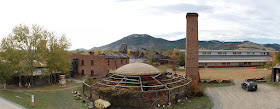By Pete Brown, Montana State Historic Preservation Officer
Brick construction is valued for its resilience, and historically, its presence indicated a sense of permanence and confidence in a community’s future. Consequently, nearly every sizeable city in Montana had nearby clay pits and brickworks to meet local demands.

In Helena, clay traveled fewer than 20 miles by rail from the Blossburg pits to Western Clay Manufacturing (now Archie Bray Foundation for the Ceramic Arts), which delivered a finished product first by wagon then by trucks to local job sites, such as the Placer Hotel. Today’s brick is made and transported hundreds of miles from out of state.
While all brick buildings embody a significant investment of energy from clay extraction to kiln firing and transport, locally made historic brick represents a smaller carbon footprint than its imported counterpart of today. Demolition of viable historic brick buildings squanders that investment of energy and expands our carbon footprint. Preservation extends the embodied energy’s dividend and enables development within the smaller carbon footprint of a century ago.
“The greenest building is the one already built.” – Carl Elefante, former president of the American Institute of Architects.
#mtshpo #carbonneutrality #climatexculture #climateheritage #mthist #nationalregisternps
Learn more:
- Placer Hotel and Western Clay properties’ listings in the National Register of Historic Places.
- Placer Hotel at https://historicmt.org/items/show/735
- Western Clay Manufacturing / Archie Bray Foundation at https://historicmt.org/items/show/822


